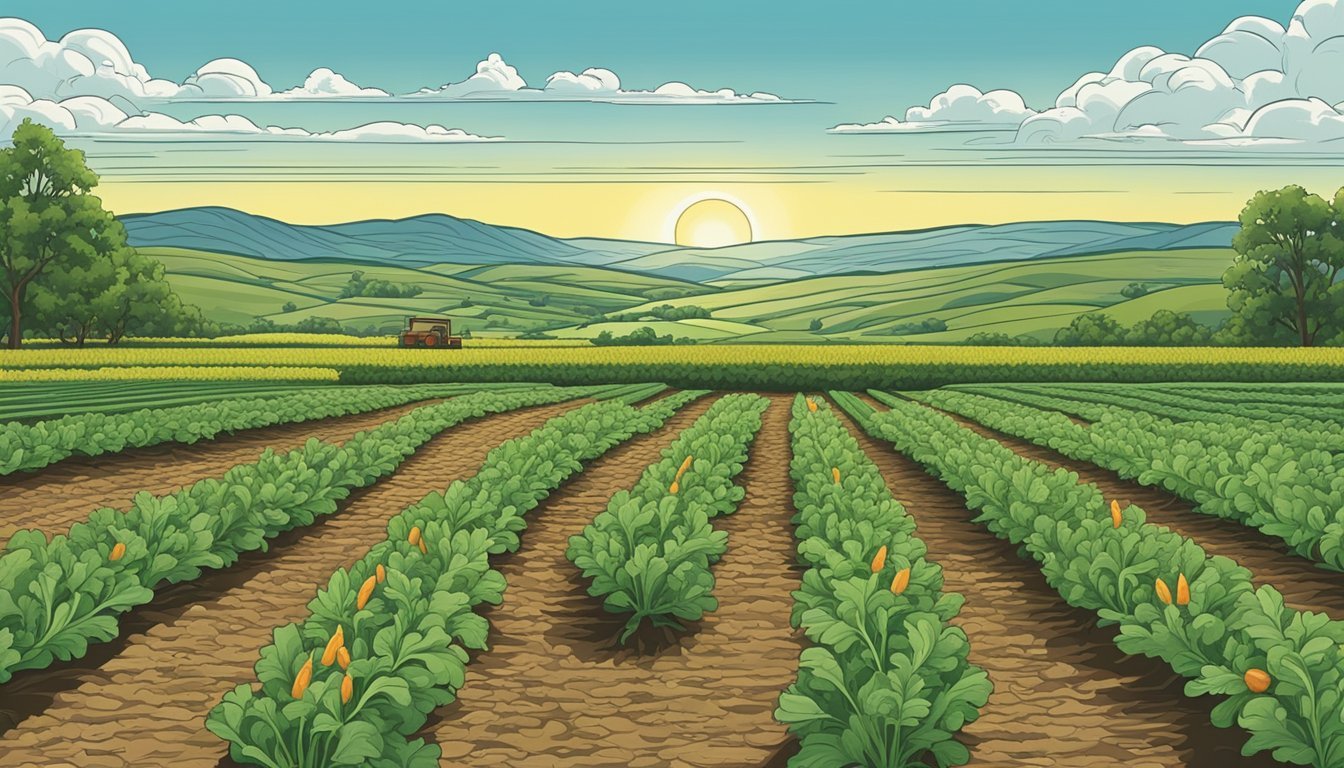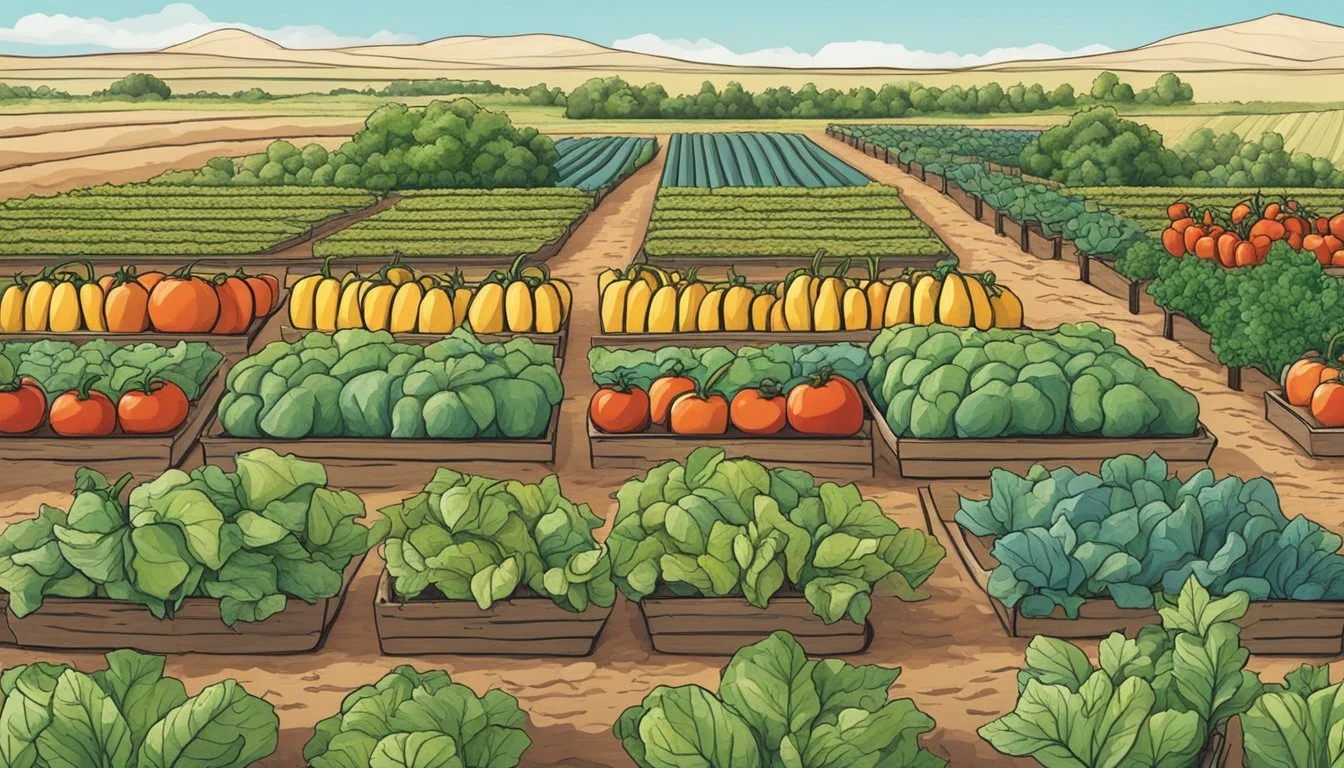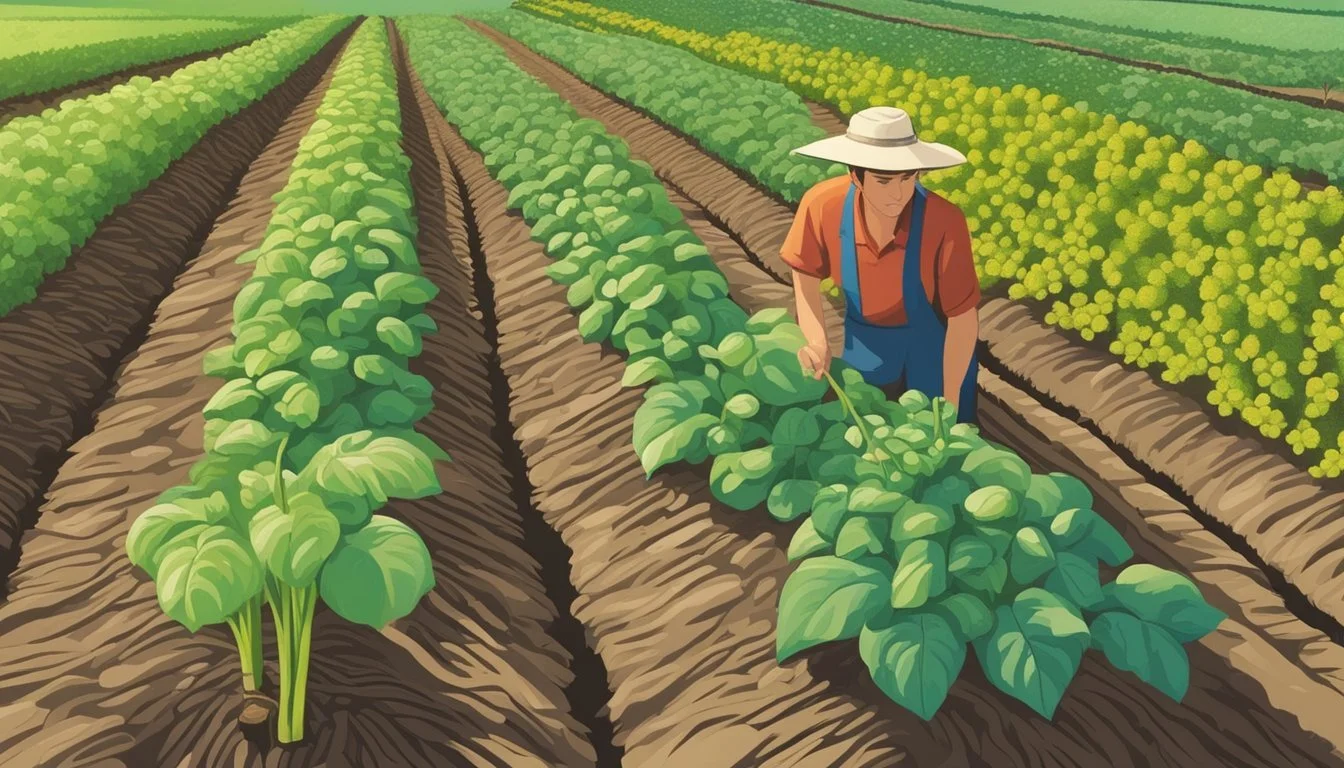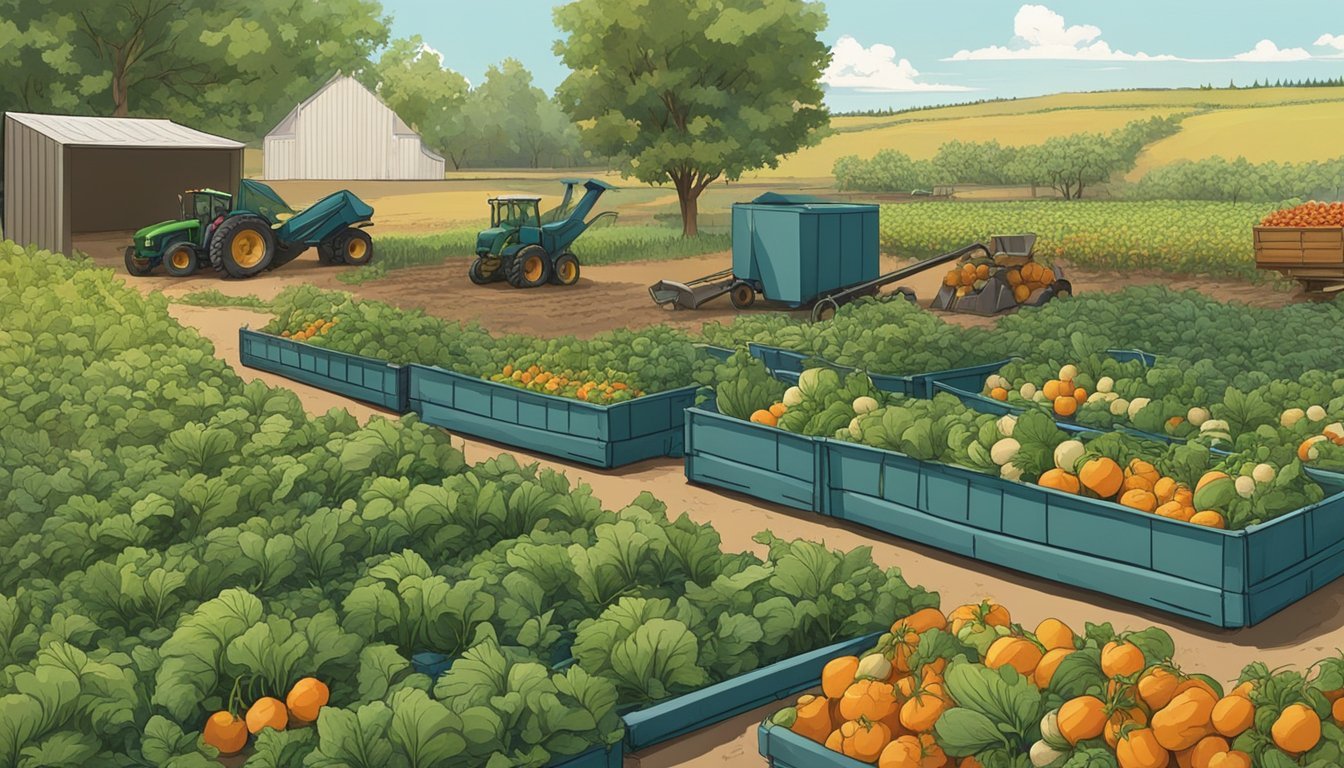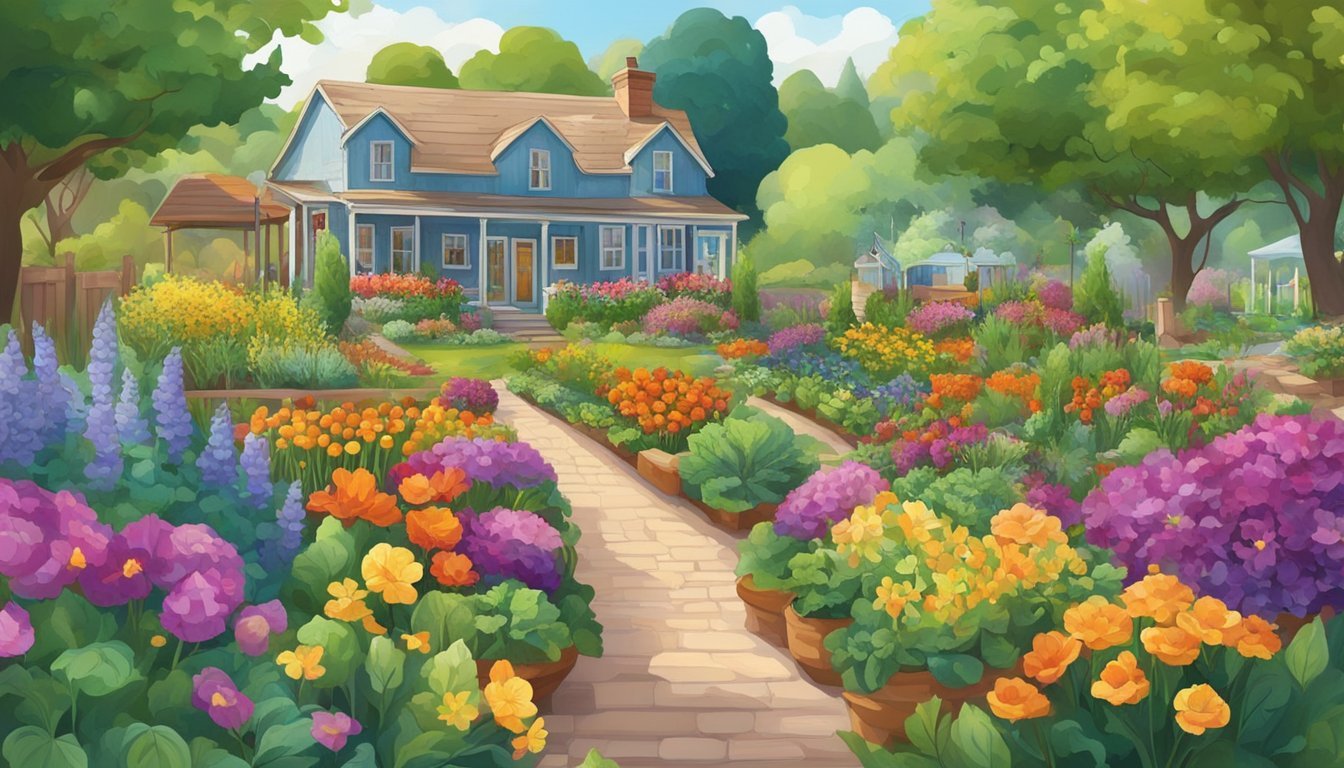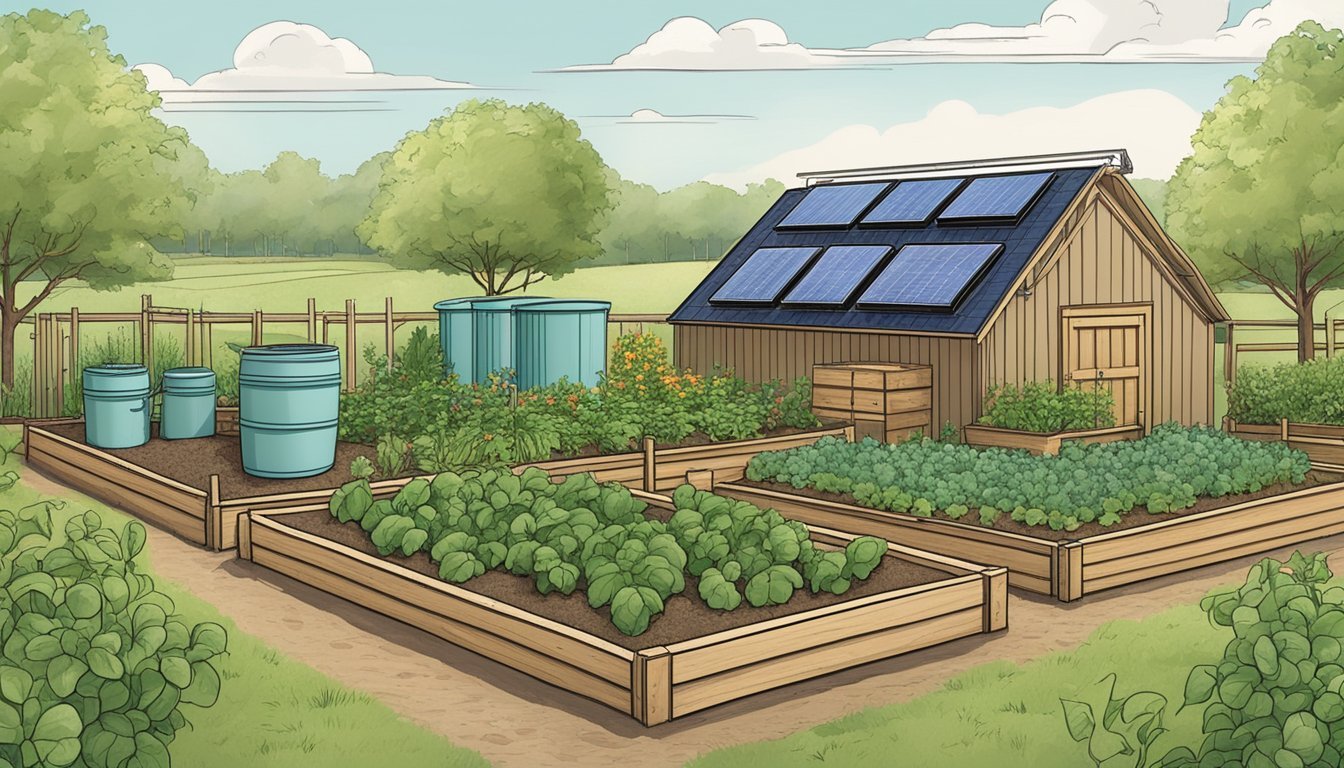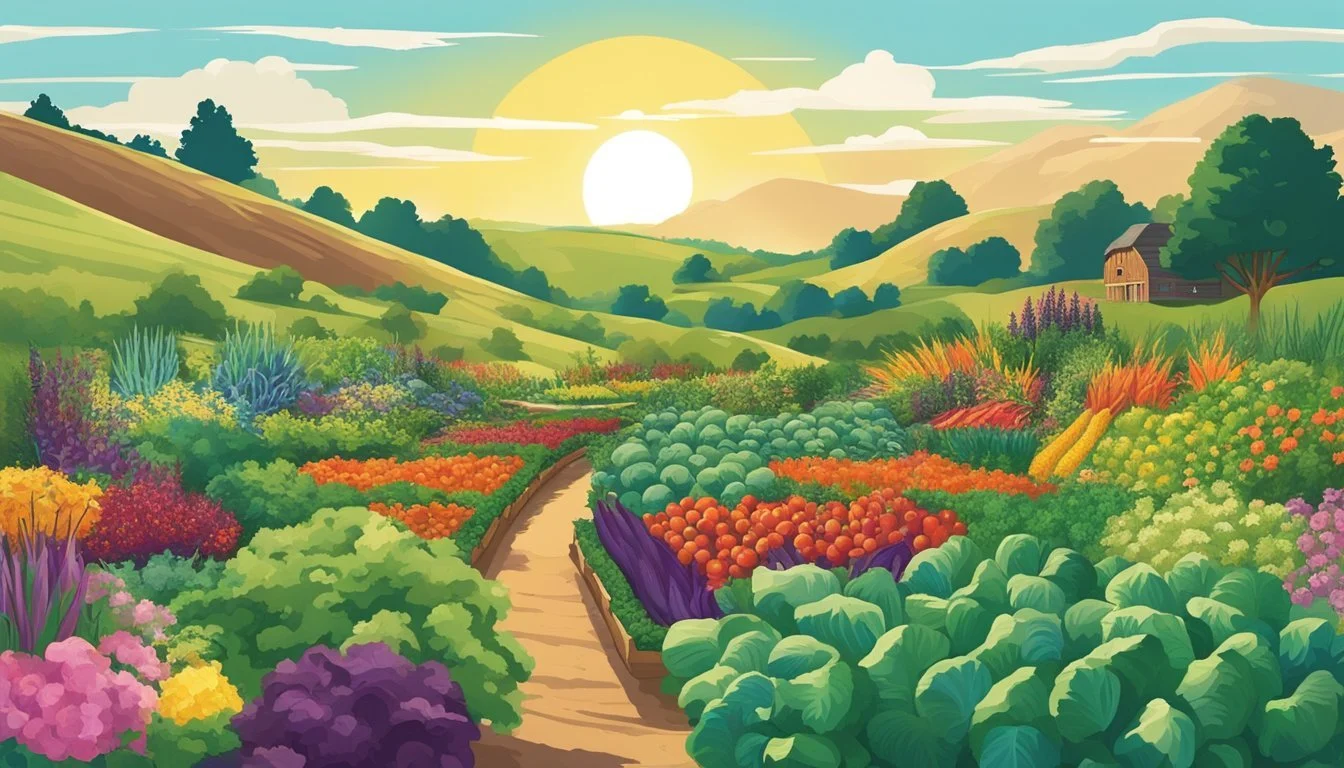Vegetable Gardening in South Dakota
A Guide for a Productive Harvest
This Article is Part of Our Guide on Vegetable Gardening by State
Vegetable gardening in South Dakota presents an opportunity for residents to engage in sustainable living and enjoy the benefits of homegrown produce. Due to the state's unique climate, certain practices and considerations are important for a successful harvest. South Dakota's gardening season can be extended with the use of techniques such as cover cropping and soil health management. Careful planting schedules and the selection of suitable vegetable varieties can result in a bountiful yield even in the region's varied weather patterns.
Gardeners in South Dakota typically find success with a range of vegetables that are well adapted to the local climate. The relatively cool springs and falls provide ideal conditions for cold-hardy vegetables like lettuce, peas, and root crops. Warm-season crops such as tomatoes, peppers, and cucumbers also flourish, especially when planted after the last frost. Knowledge of soil preparation, including pH balance and nutrient amendment, is vital as most vegetables prefer a slightly acidic soil pH ranging from 6.5 to 7.0.
The state's extension services offer resources and training for those looking to hone their vegetable gardening skills. From soil testing to pest management, South Dakota's gardeners have access to advice and best practices that cater specifically to the regional conditions. Residents are encouraged to utilize these resources to optimize their vegetable gardens, ensuring both productivity and sustainability within their growing endeavors.
Understanding South Dakota's Climate
When gardening in South Dakota, it is vital to understand the region's distinct climate zones, temperature ranges, and growing season to ensure successful vegetable cultivation.
Climate Zones and Hardiness
South Dakota spans several USDA hardiness zones: Zone 3 through Zone 5. This means gardeners must carefully select plants suited to these zones. Zone 3 experiences the coldest winters, suitable for very hardy plants, while Zone 5 is milder and can support a wider variety of vegetation, including summer squash and others that require more warmth.
Temperature Extremes and Gardening Challenges
The state deals with temperature extremes that pose unique challenges for gardeners. While winter lows can plummet to -40°F in the colder zones, summer highs might soar to around 90 degrees Fahrenheit (32 degrees Celsius), with nights often cooling off to around 60 degrees Fahrenheit (16 degrees Celsius). Extreme heat can stress plants, especially if not well adapted to full sun conditions, necessitating appropriate strategies for cool-season crops.
Season Length and Planting Times
The growing season in South Dakota can be relatively short; thus, timing is critical for planting and harvesting. Gardeners often plan to start seeds indoors or use season extension methods like high tunnels to circumvent early or late frosts. Understanding the specific planting times for each vegetable, particularly cool-season crops which thrive in the spring and fall, is essential for achieving a bountiful harvest.
Soil Preparation and Management
Proper soil preparation is crucial for a successful vegetable garden in South Dakota. Attention to soil type, health, and water management can significantly affect productivity, especially under drought conditions.
Soil Types in South Dakota
South Dakota's diverse climate and geographical regions give rise to a variety of soil types. These mainly range from the clay-rich soils in the eastern parts to the more sandy textures in the western areas. Vegetables often thrive in soil with a slightly acidic to neutral pH (6.5-7.0). It is essential to conduct a soil test to determine the specific type of soil in your garden and its pH, as this will guide any necessary amendments.
Improving Soil Health
Enhancing soil health involves a balance between fertilization, proper pH levels, and organic matter content. Gardeners are encouraged to amend soils with compost or well-rotted manure to improve nutrient content and soil structure. South Dakota State University provides guidance on amending soils for optimal garden performance.
For nutrient improvement:
Add composted organic matter.
Consider green manure crops in off-season.
For pH adjustment:
Lime acidic soils.
Sulfur can lower the pH of alkaline soils.
Water Management and Drought Considerations
Efficient water management is critical, especially during prevalent drought conditions. Drip irrigation or soaker hoses provide targeted watering, conserving this resource and ensuring that plants receive the moisture they need at the root level.
Key strategies include:
Using mulch to reduce surface evaporation.
Implementing no-till practices, as they can enhance water retention.
Timing irrigation for early morning or late evening to minimize evaporation losses.
By focusing on these practices, gardeners in South Dakota will be well-equipped to manage their soil effectively for vegetable gardening.
Selecting Vegetables for South Dakota
Gardeners in South Dakota should choose vegetable varieties that can thrive in the state's unique climate, factoring in hardiness and maturity times to ensure a successful harvest.
Popular Vegetables and Varieties
When selecting vegetables to grow in South Dakota, gardeners prefer hardy plants that can withstand the state's cooler temperatures. Lettuce is a top choice, with popular varieties like Butterhead, Boston, and Loose Leaf. These varieties are cold-hardy and can often endure frost. Other popular vegetables include:
Tomatoes – Favorable for their adaptability, but select early-maturing varieties.
Cabbage & Kale – Known for their cold resistance and hardiness.
Carrots & Radishes – Require minimal maintenance and grow well in cooler conditions.
Beans & Peas – Thrive in the cooler start of the growing season.
Squash & Zucchini – Plant after frost; includes types like crookneck and patty pan.
Peppers – Choose varieties that are marked as 'heat-tolerant' for best results.
Considering Plant Hardiness and Maturity Times
It's crucial for South Dakota growers to consider plant hardiness zones and maturity times. Vegetables like broccoli and cauliflower should be selected based on their frost tolerance, as they are cool-loving crops. Early-spring or late-maturing varieties should have a clear label indicating 'frost tolerant' to suit the state's climate conditions.
Table: Hardiness and Maturity
Vegetable Hardiness Maturity Timeframe Tomato Varies; choose cold-tolerant 50-100 days (varies) Carrots Frost-resistant 50-80 days Onions Hardy 100-175 days Green Beans Frost-sensitive; plant after last frost 50-60 days
Vegetables Suited for South Dakota's Climate
Crops that are well-suited for South Dakota's climate are those that can handle cool springs and falls, as well as occasional summer heat:
Lettuce & Salad Greens – Thrive in cold temperatures and can grow even with snow.
Root Vegetables (carrots, onions) – Perform well in well-drained, fertile soil with slight acidity (pH 6.5-7.0).
Asparagus (how long does asparagus last?) – A perennial favorite that once established, can produce for years.
Potatoes – A versatile crop with heat-tolerant options suitable for South Dakota.
When planting vegetables like tomatoes and peppers, it is a good idea to search for 'heat-tolerant' or 'widely adapted' in their descriptions, especially since these plants are typically more sensitive to temperature fluctuations. Gardening in South Dakota requires attention to both the early and late parts of the growing season to ensure that the vegetables chosen can fully mature and yield a bountiful harvest.
Garden Planning and Techniques
Effective garden planning and techniques are critical for a successful vegetable garden in South Dakota. They ensure efficient use of space, resources, and effort while accommodating the region's unique climatic conditions.
Garden Layout and Design
When designing a garden layout in South Dakota, one should prioritize sun exposure and rotation of crops. Most vegetables require at least 6 hours of direct sunlight daily to thrive and produce an abundant harvest. It's also beneficial to change the location of crops each year to prevent soil depletion and reduce the risk of pests and diseases. A well-thought-out garden design includes paths for easy access and areas defined for specific vegetables to optimize plant health and yield.
Container and Raised Bed Gardening
For gardeners with limited space or challenging soil conditions, container and raised bed gardening are efficient alternatives. Containers allow for flexibility in arrangement and can be used on patios or balconies. Raised beds improve soil drainage and can make garden maintenance more manageable. These methods are particularly recommended for vegetables like lettuce, which is known for being low-maintenance and cold-hardy, suitable for South Dakota's climate.
Vertical and Companion Planting
Vertical gardening maximizes space by growing plants upwards, which is especially beneficial for vine crops like tomatoes and cucumbers. It can also increase air circulation and reduce fungal diseases. Companion planting involves placing plants that benefit each other nearby; for example, planting basil with tomatoes can help repel pests. Here’s a simple table outlining compatible plants for companion planting:
Companion Plants Benefits Tomatoes & Basil Repels pests and improves flavor Lettuce & Carrots Optimizes space and reduces weeds
Employing these specific gardening techniques and designs can greatly enhance the productivity and enjoyment of vegetable gardening in South Dakota.
Planting and Cultivation
In South Dakota, successful vegetable gardening begins with understanding the right timing and methods for planting. They need to consider soil conditions and local climate variations to ensure healthy growth and bountiful harvests.
Starting Seeds and Transplants
Gardeners often initiate their vegetable gardens by starting seeds indoors or obtaining transplants. Seeds (how long do seeds last?) for crops like tomatoes and peppers should be started indoors 6 to 8 weeks before the last expected frost date. Transplants, on the other hand, are young plants ready to be moved into the garden after the danger of frost has passed, providing a head start compared to directly sown seeds. Straw mulch can be used around transplants to conserve moisture and regulate soil temperature.
Direct Seeding and Spacing
Vegetables such as carrots and lettuce are typically direct-seeded as they do not transplant well. South Dakotans should sow seeds directly into the garden soil, considering the following spacing guidelines to ensure proper growth:
Vegetable Row Spacing Plant Spacing Carrots 12-24 inches 2-3 inches Lettuce 12-18 inches 4-6 inches
Direct seeding should take place after the last frost date, with attention to plant spacing for optimal yields.
Care Throughout the Growing Season
Vegetables require regular care throughout their growth cycle. Gardeners should provide consistent watering, especially during dry spells. Weeding is equally crucial as weeds compete with vegetable plants for nutrients, light, and water. Plants might also require additional support structures, such as stakes for tomatoes, to promote healthy growth and fruit production. Utilizing straw as mulch can be an effective way to maintain soil moisture, suppress weeds, and keep fruit clean.
Managing Pests and Diseases
In South Dakota, gardeners must proactively manage a variety of pests and diseases to ensure healthy plant growth. Strategies vary, but successful management hinges on proper identification and understanding of each threat.
Common Pests in South Dakota
South Dakota gardens often play host to aphids and slugs, which are common pests. Aphids are small sap-sucking insects that tend to cluster on new growth or under leaves. They can transmit viruses to plants and produce sticky honeydew, which can lead to sooty mold. Slugs, on the other hand, chew irregular holes in leaves, and their preference for moist environments makes mulched areas a common battleground.
Aphids:
Identification: Small, pear-shaped insects in a variety of colors.
Management: Apply insecticidal soap or introduce beneficial insects like ladybugs.
Slugs:
Identification: Soft bodied, ranging from gray to brown, leaving a slime trail.
Management: Use slug baits or traps and remove garden debris.
Disease Prevention and Control
Disease prevention in South Dakota's vegetable gardens largely revolves around control of wilt, blight, rust, and leaf spots. Each presents unique symptoms and can significantly impact crop yield if not addressed. For example, wilt may cause plants to droop and discolor, while blight rapidly kills plant tissues. Rust typically appears as orange, powdery spots on leaves, and leaf spots manifest as discolored areas on foliage.
Wilt, Blight, Rust, and Leaf Spots:
Prevention: Rotate crops, use disease-resistant varieties, and ensure good air circulation.
Control: Remove affected plants and use appropriate fungicides as needed.
Wildlife and Insect Management
Among the wildlife, deer, rabbits, and squirrels are significant concerns. These animals can decimate a garden overnight with their feeding habits. Deer may graze on leaves and shoots, rabbits frequently nibble on tender plants, and squirrels may dig up and eat seeds and bulbs.
Deer, Rabbits, and Squirrels:
Identification: Look for bitten leaves and stems, tracks, or digging.
Management: Install fencing, use repellents, or employ scare tactics like motion-activated sprinklers.
Insects such as various beetle species also pose a threat but can be controlled through biological methods like encouraging beneficial predator insects or through chemical insecticides when necessary. Regular monitoring and early intervention are key strategies in minimizing damage from both wildlife and insects.
Harvesting and Storage
When it comes to vegetable gardening in South Dakota, employing the right harvesting and storage techniques ensures the longevity and quality of the produce. The following subsections provide guidance on effective harvesting methods, post-harvest handling, and best practices for storing vegetables.
Harvesting Techniques
Harvesting should be done at peak maturity to maximize flavor and nutrient content. For leafy greens, they should be picked in the cool part of the day to reduce wilting. Root crops like carrots and beets typically are harvested when the soil is dry to avoid excess dirt clinging to them. Using a sharp knife or shears can help to ensure a clean cut, which minimizes damage to the plant and potential disease.
Post-Harvest Handling
Immediately after harvest, vegetables should go through proper handling procedures to maintain their freshness. Washing with cold water can remove soil and cool down produce, but leafy vegetables should only be washed right before storage to prevent moisture-related decay. Delicate items like tomatoes and peppers are best not stacked too high to avoid bruising.
Storing Vegetables for Longevity
Storage conditions vary widely among different types of vegetables. Most root crops are best kept in cool, moist conditions ranging from 32°F to 40°F with 95% relative humidity. On the other hand, onions and garlic prefer dry, ventilated spaces to prevent mold growth. Utilizing storage containers that allow airflow can extend the freshness of the produce. Prolonged storage times may be achieved through methods like canning, freezing, or drying for winter use.
Resources and Local Information
Aspiring and seasoned gardeners in South Dakota can take advantage of specialized local resources for vegetable gardening. Access to expert advice, community support, and region-specific information facilitates successful gardening endeavors throughout the state.
SDSU Extension Services
The SDSU Extension offers myriad services to gardeners in South Dakota, focusing on regional agricultural strengths. These services include educational courses, such as the South Dakota Virtual Vegetable Short Course, and materials on best practices for soil preparation, plant selection, and maintenance. Gardeners in Aberdeen, Rapid City, Sioux Falls, Brookings, and Watertown can easily access these services for localized support.
Courses and Webinars: Learn via online platforms with topics ranging from beginner gardening to advanced cultivation techniques.
Publications: Find comprehensive guides on soil testing, fertilization, and crop-specific care tips.
Local Gardening Communities
Local gardening communities provide a space for individuals to share experience, seeds, and to support fellow gardeners. Cities like Aberdeen, Rapid City, Sioux Falls, Brookings, and Watertown often have gardening clubs and online groups.
Gardening Clubs: Join local clubs for workshops and events.
Online Groups: Participate in forums and social media platforms for tips and advice.
These communities serve as a valuable support network for both troubleshooting problems and celebrating gardening victories.
Gardening Tips and Tricks
Gardening in South Dakota requires awareness of the local climate, including hardiness zones and seasonal temperatures. Hardiness zones in South Dakota range from zone 3 to zone 5, which influence which vegetables can thrive.
For successful results, one should prioritize timing. Vegetables such as radishes benefit from being sown at the correct time—too close planting may inhibit their size and flavor.
Exercise caution with plant spacing. For instance, larger vegetables like Jersey King asparagus demand more room, whereas compact varieties like Viking can tolerate closer quarters.
Leafy vegetables including various types of lettuce, like butterhead, are versatile and well-suited for South Dakota gardens. These leaf vegetables also do not require as much space and can be planted in both spring and fall.
Here's a quick reference for vegetable planting:
Vegetable Planting Time Spacing Special Notes Radishes Early spring and fall 1 inch apart Avoid overcrowding Butterhead Lettuce Early spring and fall 6-8 inches apart Prefers cooler temperatures Asparagus (Jersey King) Plant crowns in early spring 18 inches apart Requires patience; perennials that produce for years
Consider diverse environments within your garden, such as shaded spots and sunny areas. Some vegetables, like Martha Washington asparagus, are cold hardy, while others, like the fig, thrives in heat.
Incorporate trees strategically to provide necessary shade for heat-sensitive crops or as windbreaks to protect more vulnerable plants. Such planning leads to a balanced garden ecosystem, fostering robust growth and better yields.
In summary, integrating these tips and understanding the specific needs of each plant will ensure a flourishing vegetable garden in South Dakota's unique climate.
Fertilization and Nutrition
Proper fertilization and nutrition are crucial for the successful growth of vegetable crops in South Dakota. They ensure yield and quality by fulfilling the plants' nutrient needs.
Understanding Fertilizer Types
Fertilizers come in various forms and compositions, catering to the specific nutritional needs of vegetable crops. There are generally two broad categories: organic and inorganic fertilizers. Organic fertilizers are derived from natural sources such as compost, manure, or bone meal, and release nutrients slowly into the soil. In contrast, inorganic fertilizers are synthesized chemicals providing quick nutrient availability. South Dakota gardeners often use a blend of both types to balance the immediate and long-term nutritional demands of their gardens.
In terms of composition, fertilizers typically feature a combination of three primary nutrients listed as N-P-K ratios on the packaging, representing nitrogen (N), phosphorus (P), and potassium (K). Nitrogen promotes leafy growth, phosphorus supports root and flower development, and potassium is crucial for overall plant health.
Nutrient Requirements for Vegetable Crops
Each vegetable crop has its own nutrient requirements, and gardeners in South Dakota need to tailor their fertilization strategy accordingly. For instance:
Leafy vegetables like lettuce and spinach demand higher levels of nitrogen.
Root crops such as carrots and potatoes benefit from higher phosphorus levels for root development.
Fruiting vegetables, like tomatoes and peppers, require a balanced approach with an emphasis on potassium as fruits begin to develop.
Moreover, soil tests are recommended to determine existing soil nutrient levels and pH. This helps to customize the fertilization plan to avoid over or under-application of nutrients. For example, most vegetables prefer slightly acidic soil conditions (pH 6.5-7.0). Gardeners might need to amend soils based on soil test results to achieve optimal pH and nutrient balance. Soil should be sampled to a depth of 6 inches, using tools like a garden trowel or spade, avoiding any surface litter to ensure accurate results.
Garden Maintenance and Upkeep
Proper garden maintenance and upkeep are essential for a thriving vegetable patch, especially in South Dakota's variable climate. Gardeners must be diligent in regular watering, especially during dry spells, to ensure plants receive adequate moisture. One should establish a consistent watering schedule, considering that early morning is typically the best time to water to reduce evaporation losses.
Weed control is another crucial aspect. Weeds compete with vegetables for water, nutrients, and sunlight, so maintaining a weed-free garden will benefit plant health and yields. Regular hoeing and hand-pulling of weeds are effective strategies. In addition, mulching helps suppress weed growth, retain soil moisture, and regulate soil temperature.
Here is a brief guide on applying mulch:
Types of Mulch: Organic options such as straw, wood chips, or compost are beneficial.
Thickness: Apply a 2-3 inch layer of mulch around plants, avoiding direct contact with stems.
Timing: Mulch after the soil has warmed up in spring and replenish as needed through the growing season.
A table summarizing the maintenance tasks:
Task Frequency Tips Watering As needed (1-2 inches per week) Water early in the day; use drip irrigation to minimize waste. Weed Control Regular intervals Mulch and remove weeds before they seed. Mulching Once in spring and replenish as needed Organic mulches enrich the soil as they decompose.
Gardeners should respond to their garden's needs promptly and adjust their maintenance routine as necessary throughout the growing season. Stay vigilant against pests, and diseases and be proactive in mitigating these challenges when they arise. With consistent care, South Dakota gardens can flourish, providing an abundance of fresh vegetables.
Extending the Growing Season
Gardeners in South Dakota can extend their growing season by taking advantage of protective structures and employing a variety of season extension techniques. These methods can help mitigate the challenges posed by the state's climate, such as early frosts and variable temperatures.
Using Protective Structures
Protective structures create microclimates that shield plants from harsh weather. Two common types of structures include:
Cold Frames: These are simple, bottomless boxes with a clear lid that traps heat. Cold frames can be used to plant earlier in spring and to keep vegetables growing later into fall.
High Tunnels or Hoop Houses: These are unheated greenhouses that can extend the growing season by several weeks to months. They provide temperature control and protection from wind and heavy rain.
Season Extension Techniques
Several techniques are applicable to the South Dakota climate, each with its specific uses:
Mulching: Applying organic materials such as straw or leaves around plants retains soil moisture and regulates temperature, protecting roots from sudden temperature changes.
Row Covers: Made of lightweight fabric, these covers protect plants from frost, extending the growing season in both spring and fall.
Timely Planting: Gardeners should plant cold-tolerant varieties earlier in the season and transition to heat-loving plants as temperatures rise.
Succession Planting: This involves planting new crops as others are harvested, ensuring a continuous supply of vegetables throughout the season.
Garden Beauty and Aesthetics
Creating an aesthetically pleasing vegetable garden combines practicality with the allure of nature. By incorporating ornamentals and applying fundamental design principles, one can create a functional space that is both productive and visually appealing.
Incorporating Flowers and Ornamentals
Integrating flowers and ornamentals into the vegetable garden enhances its beauty and contributes to a healthy ecosystem. Marigolds, for instance, add vibrant color and can deter pests, making them excellent companions for vegetables. Strategic placement of flowers like sunflowers can create visually striking patterns and provide support infrastructure for climbing plants. It is not just about aesthetics; flowers can also attract pollinators, aiding in the efficiency and yield of the vegetable garden.
Design Principles for Attractive Vegetable Gardens
When designing a vegetable garden, one should consider practicality alongside beauty. Use pathways and bed shapes to create a sense of order; simple geometric patterns or flowing curves can be both attractive and functional. Raised beds can provide visual structure and improve access to the plants. The color of vegetables and plants, like the purple foliage of eggplants or the rich greens of lettuce varieties, can be arranged to create a tapestry of hues. Texture variation, ranging from the feathery tops of carrots to the broad leaves of squash, adds depth and interest to the garden landscape.
Sustainability and Eco-Friendly Practices
Gardeners in South Dakota are increasingly implementing practices that contribute to sustainability and ecological balance within their vegetable gardens. These approaches not only bolster crop productivity but also support environmental health.
Sustainable Practices: Farmers utilize cover crops to enhance soil quality and decrease erosion. By integrating cover crops, they also manage pests and weeds more effectively, reducing the need for synthetic chemicals. This practice aligns with the principles of integrated pest management, which seeks to use natural predation rather than chemicals where possible.
Organic Gardening: Many South Dakotan gardeners opt for organic methods to maintain soil fertility and plant health. They employ organic matter, like compost, which amends the soil structure and nourishes plants without the harmful side effects of chemical fertilizers. The aim is to create a self-sustaining system that minimizes external inputs.
Biodiversity: Emphasizing biodiversity, gardens feature a variety of plant species, which in turn foster a balance of insects and wildlife. This diversity is critical for ecological health as it provides habitat and natural mechanisms for pest control.
Soil Health: Practices such as proper pH maintenance, indicated to be ideal between 6.5 and 7.0, promote a thriving garden ecosystem.
Sustainable Community Projects: These serve as hubs for knowledge-sharing on eco-friendly gardening techniques.
Embracing these eco-friendly strategies ensures that vegetable gardening in South Dakota remains a sustainable endeavor, enriching both the land and the local communities.
Health Benefits of Gardening
Gardening offers a variety of health benefits that can enhance one's quality of life. Its physical aspect serves as a form of exercise, contributing to overall health improvement.
Exercise: Engaging in gardening activities like digging, planting, weeding, and watering involves physical movement that can increase one's heart rate and improve stamina. Regular garden maintenance can be equated to moderate cardiovascular exercise.
Mental Health: The act of nurturing plants and being in contact with the soil can reduce stress levels. Horticultural therapy has been recognized for its role in improving mental health, with studies showcasing a reduction in symptoms of depression and anxiety among gardeners.
Nutrition: Growing one's own vegetables ensures access to fresh produce, which can lead to better eating habits. Vegetables from the garden are often more nutrient-dense, as they are consumed closer to their harvest time compared to store-bought produce that may have traveled long distances.
Vitamin D Exposure: Gardeners typically spend time outdoors in the sunshine, which allows their bodies to naturally produce Vitamin D. This vitamin is crucial for bone health and a strong immune system.
Weight Management: The combination of physical activity and potential improvements in diet, as a result of consuming more home-grown vegetables, can support weight management efforts.
In conclusion, gardening in South Dakota is not just a rewarding hobby but also a substantial contributor to physical health and psychological well-being.
Community and Social Aspects of Gardening
Community gardens play a pivotal role in enhancing social interaction and fostering a sense of community in South Dakota. These shared spaces are not just about cultivating plants; they are about cultivating relationships within the community.
Key Benefits:
Social Interaction: Community gardens provide a platform for gardeners to connect, share tips, and support each other. They become a hub for individuals of diverse backgrounds to unite over a common interest in gardening.
Learning Opportunities: Gardening workshops, like those offered by SDSU Extension, often accompany these community spaces, offering residents chances to learn and grow together.
Community Gardens: A Social Hub
At the heart of a community garden lies the opportunity for locals to meet and collaborate. These gardens serve as outdoor classrooms where knowledge is passed on and skills are honed. For example:
Workshops: SDSU Extension provides educational series that enhance horticultural knowledge within community gardens.
Volunteering: Residents play an active role, fostering accountability and stewardship for their neighborhood.
Collaboration in Action
Community Vitality: Garden coordinators often work with volunteers to tailor garden-based interventions that benefit the entire community.
Shared Success: A bounty of fresh vegetables from these gardens symbolizes the community's collective effort and success.
The Wrap-up
Gardening in South Dakota is more than sowing seeds; it's about cultivating community spirit and reaping the rewards of shared social experiences. Participation in community gardens positively impacts social cohesion, offering a place for interaction, collaboration, and mutual support.
Advanced Gardening Techniques
In the context of South Dakota's diverse climate, advanced gardening techniques such as grafting, hydroponics, and aeroponics can significantly enhance vegetable production.
Grafting is a method where parts of two plants are joined together to continue their growth as one. In South Dakota, grafting can be used to combine a hardy rootstock with a fruit-bearing scion to create plants that are more resistant to soil-borne diseases and extreme weather conditions.
Benefits of Grafting:
Disease Resistance
Enhanced Growth
Improved Yield
Hydroponics, the practice of growing plants in a water-based, nutrient-rich solution without soil, suits indoor environments, granting South Dakota gardeners the ability to grow vegetables year-round despite harsh winters.
Hydroponic Systems Include:
Nutrient Film Technique (NFT)
Deep Water Culture (DWC)
Ebb and Flow
Aeroponics is a process where plants are grown in an air or mist environment. It's a soil-less growing method where roots are suspended in the air and misted with nutrients and water, leading to faster growth and higher yields.
Aeroponic Advantages:
Efficient Water Usage
Greater Oxygen Access
Faster Plant Growth
Both hydroponics and aeroponics offer control over the growing environment, allowing for precise management of nutrients and pH levels. Gardeners can leverage these techniques to maximize vegetable production, particularly in urban settings where traditional garden space may be limited. These methods are a testament to the innovation in agricultural practices, providing sustainable options for South Dakotan gardeners.

